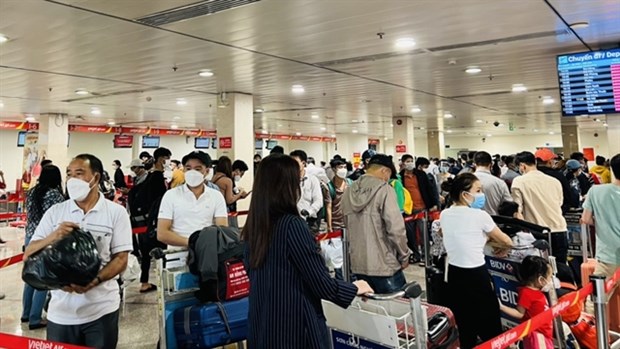Airport planning must ensure financial feasibility, efficiency
Careful consideration must be given to the planning and development of airports to ensure feasibility, experts have warned, as localities across the country propose the airports in their provinces.
 Crowded Tan Son Nhat International Airport in HCM City. (Photo: VNA)
Crowded Tan Son Nhat International Airport in HCM City. (Photo: VNA)During the past few weeks, three provinces, including Tuyen Quang, Son La and Kon Tum, sent documents to the Ministry of Transport proposing airports in their provinces be added to the national airport planning.
Ninh Binh, Ha Tinh, Ninh Thuan, Dak Nong, Ha Giang, Bac Giang and Binh Phuoc provinces also raised similar proposals in the past.
While four plans for road, maritime, inland waterway and railway are already approved, planning for the national airport system in the 2021-30 period has not yet been completed.
Aviation expert Nguyen Bach Tung said as the planning continues, localities are applying for permission to build airports to promote socio-economic development.
According to statistics of the Civil Aviation Authority of Vietnam, there are currently 22 airports for civil use in Vietnam, though only Van Don International Airport was developed with private investment.
Under the Ministry of Transport's draft, nine more airports will be developed by 2050, bringing the total airports for civil use to 31.
The six airports to be developed by 2030 are Long Thanh, Phan Thiet, Quang Tri, Sa Pa, Lai Chau and Na San. By 2050, a further three, Cao Bang, Hai Phong and a second airport for Hanoi, will be developed.
Tung said that from each locality's perspective, the airport development proposal is understandable as it would help promote tourism and local economic development. However, when looking at the master planning for the country, the rampant development of airports would cause many problems.
"The national airport network needs appropriate planning to avoid airspace conflicts while ensuring investment efficiency," he said.
Tung cited statistics that in pre-pandemic 2019, there are only four airports handling over nine million passengers. They were Tan Son Nhat (41 million), Noi Bai (29 million), Da Nang (15.5 million) and Cam Ranh (9.7 million).
The privately-invested Van Don Airport received only 259,000 million passengers.
Tung said it would be difficult for a newly-built airport to get a capital return if it receives less than five million passengers per year, adding that the above figures warned provinces and cities wanting to invest in airports following Build Operate Transport practices.
According to Nguyen Thien Tong, former head of the Aviation Engineering Department under the Ho Chi Minh City University of Technology, airlines, particularly private ones, should be hesitant to open routes to airports that are not attractive to passengers.
He said that it would not be enough if each airport served only two or three flights per day.
Localities must give careful consideration to the development of airports. At the same time, the Ministry of Transport must consider the feasibility and efficiency of developing the national airport planning because many small airports have been running at a loss for many years.
Nguyen Bach Tung, deputy director of the ministry's Transport Engineering Construction and Quality Management Bureau, said most domestic airports do not yet operate at their designed capacity, even those newly built with large capacity such as Van Don and Can Tho.
One of the most important issues when deciding to build an airport was carefully calculating the investment efficiency, Tung said, adding that the airport development would not be appropriate if the travel distance were too close.
Tran Quang Chau, president of the Vietnam Association of Aviation Science and Technology, said that the planning must be based on several factors such as travel distance between airports, travel demand and the development of flight routes for each airport, as well as economic efficiency factors.
An expert even warned that proposals of adding airports to the planning by some localities were quite infeasible but had significant impacts on the real estate market, which inflated land prices. Airport planning should be completed and issued early to prevent land speculation.
According to the Ministry of Transport, 28 airports by 2030 would help increase the total airport capacity to about 283 million passengers per year and ensure that over 95% of the population have access to one airport within a 100km vicinity. This density is appropriate compared to other countries such as Thailand and Malaysia.
A representative from the Civil Aviation Authority of Vietnam, the airport development should be focused and investing in developing large-scale ports to create breakthroughs. The viewpoint was to develop synchronously, he said, adding that airports were a necessary but not a sufficient condition for the development of a province.
Airport development should also align with the country's long-term development goals, such as investment attraction and tourism promotion, to create ground for the economy to take off.
Transport Engineering Design Inc (TEDI) states that new airport development must be based on six main criteria: travel demand, socio-economic factors, national security, emergency relief, natural conditions, and distance arrangement./.













